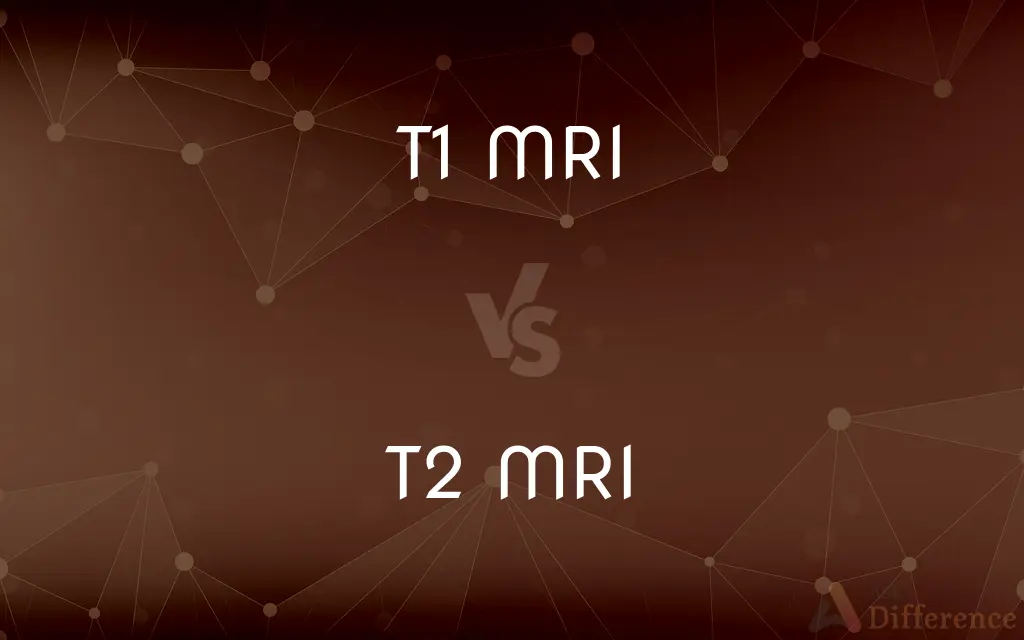T1 MRI vs. T2 MRI — What's the Difference?
Edited by Tayyaba Rehman — By Fiza Rafique — Published on November 1, 2023
"T1 MRI highlights fat, showing anatomy/anomalies; T2 MRI shows water/fluid, useful for pathology. Both use magnetism and radio waves."

Difference Between T1 MRI and T2 MRI
Table of Contents
ADVERTISEMENT
Key Differences
T1 MRI, or T1-weighted magnetic resonance imaging, is a medical imaging technique that emphasizes the visualization of fat within the body, making it excellent for depicting anatomical details like the contours of muscles, organs, and the brain. Conversely, T2 MRI, or T2-weighted magnetic resonance imaging, contrasts this by highlighting water and fluid content in tissues, which is particularly useful in detecting pathological changes like edema, inflammation, or infection.
T1 MRI produces images where fat appears white, providing clear, detailed pictures that are instrumental in identifying the fine structures of the brain, muscles, and other tissues. On the other hand, T2 MRI makes areas with water or fluid appear bright, allowing medical professionals to easily identify bodily fluids and changes associated with various medical conditions, including tumors, cysts, or brain disorders.
T1 MRI is particularly effective in imaging the musculoskeletal system, identifying body fat composition, and outlining organ boundaries, making it invaluable in detailed anatomical studies. In contrast, T2 MRI is vital for visualizing bodily regions with high moisture content, like the spinal cord or brain, and is indispensable in diagnosing diseases where tissue water content is a marker.
T1 MRI, because of its preference for fat, can accurately image organ structures and is often used post-contrast to view blood vessels and inflammation. T2 MRI, however, is ideal for scenarios where fluid distinction is critical, such as when detecting hydronephrosis, or for viewing cerebrospinal fluid in the brain and spinal cord.
T1 MRI is typically utilized when a high-resolution image of soft tissue is required, as it provides a greater contrast between different tissues. T2 MRI, contrasting, is employed when there's a need to differentiate between solid masses and fluid-filled spaces, making it essential for comprehensive diagnostics in areas like neurology, orthopedics, and oncology.
ADVERTISEMENT
Comparison Chart
Primary Highlight
Fat
Water/Fluid
Image Appearance
Fat is white/bright
Fluid is white/bright
Common Use
Anatomy, organ boundaries
Pathology, fluid detection
Post-Contrast Use
Enhancing blood vessels, inflammation
Detecting edema, infections
Diagnostic Application
Musculoskeletal, brain anatomy
Neurology, orthopedics, oncology
Compare with Definitions
T1 MRI
A fat-sensitive scan used in detailed anatomical studies.
Post-contrast, the T1 MRI clearly showed the vascular anomalies.
T2 MRI
Imaging used for detecting pathology involving fluids.
The radiologist used T2 MRI to distinguish the cyst from solid tissue.
T1 MRI
An imaging technique providing detailed body structures.
A T1 MRI was crucial in planning the complex neurosurgery.
T2 MRI
A scan sensitive to moisture, indicating various diseases.
With T2 MRI, doctors identified the subtle brain edema.
T1 MRI
MRI approach focusing on fat tissues for high resolution.
The T1 MRI revealed detailed musculoskeletal structures for diagnosis.
T2 MRI
A type of MRI highlighting water and fluid in tissues.
T2 MRI helped diagnose the patient's spinal cord inflammation.
T1 MRI
Utilized for clear imaging of anatomical boundaries and organs.
The T1 MRI accurately mapped the brain's intricate structures.
T2 MRI
Employed where fluid distinction is crucial in diagnostics.
T2 MRI was pivotal in detecting the patient's inner ear infection.
T1 MRI
A type of MRI that emphasizes fat in the body.
The doctor ordered a T1 MRI to examine the patient's liver anatomy.
T2 MRI
Essential for comprehensive diagnostics in fluid-filled areas.
Neurologists rely on T2 MRI for detailed brain and spinal cord images.
Common Curiosities
When should a T1 MRI be used over a T2 MRI?
T1 MRI is used for detailed anatomy, organ boundaries; T2 MRI for pathology, fluid detection.
Why does fat appear bright on T1 MRI?
Fat has a shorter relaxation time, making it appear brighter on T1 MRI.
Are there risks involved in T1 or T2 MRI procedures?
Both T1 and T2 MRI are safe, non-invasive, but caution is needed for patients with implants.
Is T2 MRI better for detecting brain disorders?
Yes, T2 MRI is often superior for brain conditions due to high fluid visibility.
Can T1 and T2 MRI be performed simultaneously?
Yes, both T1 and T2 MRI sequences are often part of a single comprehensive MRI examination.
Why are T2 MRI images more useful in diagnosing tumors?
T2 MRI shows fluid content and changes, crucial for identifying tumors.
How do patients prepare for T1 or T2 MRI?
Preparation is similar for both: removing metal objects, and fasting if contrast is used.
Do T1 and T2 MRI use radiation?
No, both use magnetic fields and radio waves, not ionizing radiation.
Are contrast agents used in both T1 and T2 MRI?
Contrast agents are more commonly used in T1 MRI for vascular imaging.
What's the cost difference between T1 and T2 MRI?
Costs are comparable; variations depend more on location, contrast use.
How long do T1 and T2 MRI scans take?
Scan times vary, but both T1 and T2 MRI may take 30 minutes to an hour.
Can both T1 and T2 MRI be used in musculoskeletal diagnoses?
Yes, but T1 MRI is better for anatomy, while T2 MRI highlights inflammation, edema.
Which MRI type is better for soft tissue imaging?
Both are effective, but T1 MRI often provides higher resolution for soft tissue contrast.
Can T1 and T2 MRI differentiate tissue types?
Yes, T1 MRI is excellent for fat differentiation; T2 MRI for water/fluid tissues.
Are T1 and T2 MRI effective in stroke evaluation?
Yes, especially T2 MRI for detecting cerebral edema and ischemia.
Share Your Discovery

Previous Comparison
Watts vs. Volts
Next Comparison
Inkjet vs. DeskjetAuthor Spotlight
Written by
Fiza RafiqueFiza Rafique is a skilled content writer at AskDifference.com, where she meticulously refines and enhances written pieces. Drawing from her vast editorial expertise, Fiza ensures clarity, accuracy, and precision in every article. Passionate about language, she continually seeks to elevate the quality of content for readers worldwide.
Edited by
Tayyaba RehmanTayyaba Rehman is a distinguished writer, currently serving as a primary contributor to askdifference.com. As a researcher in semantics and etymology, Tayyaba's passion for the complexity of languages and their distinctions has found a perfect home on the platform. Tayyaba delves into the intricacies of language, distinguishing between commonly confused words and phrases, thereby providing clarity for readers worldwide.












































